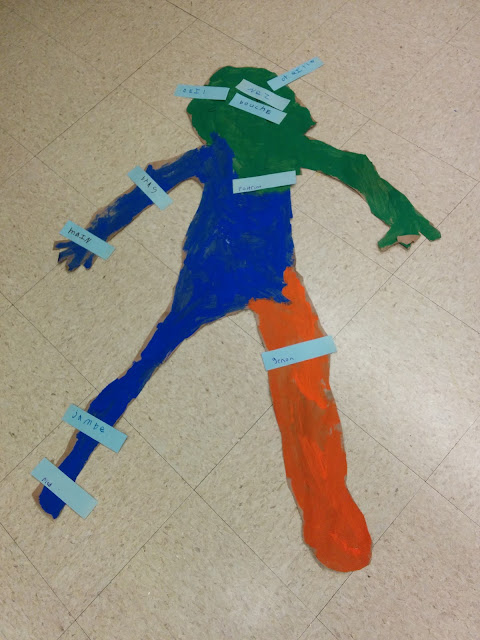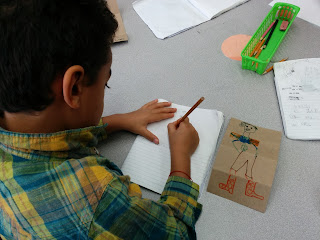We are now finishing up our 11th week at school. I will briefly outline our activities over the 9 week hiatus in blog entries.
In writer's workshop, the kids have been learning to tell and write simple stories in French. We had a visiting storyteller, Agnes Salmon, come and teach us rhymes and a story, Loupscaroux. The kids and I practiced telling the story with gestures and on a subsequent visit we told the story back to Agnes. We have also been telling made-up stories around the circle, passing a talking piece and having each child add the next sentence of the story. When the kids put their stories into writing, they use invented spelling and known sight words. We have looked at the importance of leaving spaces between words and the need for punctuation. The students are still very keen to read their stories to the class each day. After each reading, the other students are invited to ask questions or make comments. Currently, I am highlighting the vocabulary for asking questions in French. We are shifting over now to the expectation that any comment or question on the carpet happens in French.
Our alphabet review is up to the letter "t". We have learned the gestures for most of the phonemes (sounds in words) and we practice reading with those gestures in a group. We continue to have weekly sight words which we read often, make sentences with, and copy down at the end of the week. So far these have highlighted a vowel sound each week, including é and è. This week the weekly sight words highlight the letter "c" and we are learning about hard and soft "c". Together we made up a story about how the letter "c" is confused and needs help from his friends (a, e, i, o, u, y, l, r) to know whether he makes the sound "s" or the sound "k." We are learning to tell the story aloud together using puppet-like props for each letter.
We also have been singing regularly: "Merci maman la terre" by Arthur L'aventurier (available on itunes, on his Les saisons en ballon album); "Tout ce dont j'ai besoin"(a translation I did of Raffi's "All I Really Need",
https://www.youtube.com/watch?v=eerjiaH8dRE); and Les squelettes (
https://www.youtube.com/watch?v=0CKMaRwicSg). These are the songs we will be singing at Kensington Gardens for the French Club there.
I read storybooks aloud to the kids almost every day, and we have been focusing on making connections as readers. I use a puppet, "Fleur Connecteur," to model the way we make connections between texts and other texts, between texts and our lives, and between texts and the wider world. In Daily 5 time the kids have been doing "read to self" with success. Each student has a blue bag with 2 levelled readers, which they read during that time. They are free to choose new readers when they get proficient at the ones they have, at the level where they have some fluency. The home reading program is off to a good start, thanks to the parents helping me photocopy all those books!
In math we have done a lot of counting, by 2s, 5s and 10s to 100. We did another unit that used a storybook as the jumping off point, this one was called "Grandma's necklaces." Through it we explored skip-counting and patterning. We delved into doubling, and odd and even numbers. We have been fortunate to have a math coach, Julia Atkins, visiting us regularly to support our investigations. The kids are now gaining confidence with the French vocabulary surrounding addition and subtraction, as we work orally to make math sentences. We have used ten frame images to establish the benchmarks of 5 and 10, meaning that the kids are learning to relate the single digit numbers to 5 and 10. Developing this number sense is a key goal in grade 1, so that students have a richer knowledge of 7, for example, as 2 more than 5 and 3 less than 10.

We have also had our Collections days, celebrating the 20th, 30th and 40th days of school so far. The kids work with counting mats that have them group their items and then count the groups. So for 40, for example, they made groups of 5 and counted to determine that there are 8 groups of 5 in 40. This activity helps them get comfortable with unitizing (counting groups as units) which is the basis for place value understanding (knowing that the 1 in 12 represents 1 group of 10).

In social studies, we have been learning about feelings, needs, community, responsibility and respect. We spent time learning the vocabulary around these issues, and sometimes in the morning circle we pass a talking piece and each child lets the class know how they are feeling today. The kids made little books with feeling words and drawings of faces to illustrate these. We established that good feelings are connected to our needs being met, and stressful or uncomfortable feelings are a sign that our needs are not being met. We talked about the meaning of community, and the kids drew and talked about the communities they are a part of (family, classroom, etc.). Then in groups of 3 I asked the kids to create skits, one for each student in the group, that show a situation illustrating a feeling and connecting it to a need. The skits were planned through drawing and by writing a sentence, and then each child was the director of their own skit and wore a special scarf to signify their leadership. The skits were performed for the class, with each director speaking the sentence and then acting it out with their group.

Our big art project in October was making apple doll witches and wizards, which are now proudly displayed in the school foyer.
We also made rubbings of leaves which were added to garlands exploring different kinds of lines.

And this past week, we made poppies from tissue paper to put together a wreath for the Remembrance Day assembly.











































